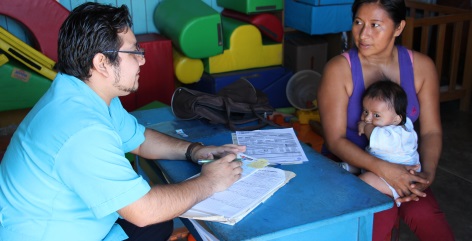GLI Peru
GLI Peru
Perú. Santa María de Nieva y San Lorenzo
- Beneficiarios directos · 30.696
- Beneficiarios indirectos · 76.742
El GLI-Perú es un proyecto que se inició en 2013 con UNICEF como contraparte. Esta iniciativa tiene la finalidad de disminuir las inequidades sanitarias que afectan especialmente a las comunidades indígenas. El proyecto focaliza su actividad principalmente en dos áreas, en la zona de Condorcanqui (Amazonas) a través del Hospital Santa María de Nieva y en Datem de Marañón, con el Centro de Salud de San Lorenzo.

La mortalidad infantil y materna en Perú se ha reducido significativamente estas dos últimas décadas, gracias al incremento de la cobertura del control prenatal y de la atención al parto. El país ha alcanzado uno de los Objetivos del Milenio (ODM) ya que ha reducido su mortalidad infantil a la cifra de 17 muertes por cada mil nacidos.
A pesar de los logros, las desigualdades siguen presentes entre la población residente en zonas urbanas y las rurales, especialmente las comunidades del Amazonas. Mientras que en el entorno urbano el 92% de los partos son atendidos por profesionales, en el entorno rural sólo son atendidas el 45% de las mujeres. Esta desigualdad es consecuencia directa de la escasez de personal sanitario que identifique las necesidades y la cultura de la población indígena amazónica.
Con un 75% de población indígena, Awajum y Wampi, los laboratorios del Hospital de Nieva en Condorcanqui, y el Hospital de San Lorenzo en Datem de Maranón se encuentran sin recursos para el adecuado diagnóstico de las principales enfermedades de la zona.
El objetivo del proyecto GLI-Perú es mejorar esta situación y contribuir a asegurar un mejor acceso al derecho a la salud de las comunidades indígenas. La Fundación Probitas, en colaboración con UNICEF y el Ministerio de Salud, ha creado el primer modelo de atención integral de VIH/Sida, Hepatitis B y ITS, para adaptar el protocolo nacional a este contexto.
Fases del Proyecto
Durante la primera fase, se elaboró un diagnóstico de la situación "needs assessment", teniendo en cuenta los factores culturales y demográficos de las comunidades y analizando las estructuras sanitarias existentes hasta la fecha. El equipo de la fundación llegó a la conclusión que era necesario:
- La rehabilitación de los espacios y el refuerzo de la instalación de Internet.
- La reparación de las instalaciones de agua existentes
- La instalación de estructuras eléctricas con un sistema sostenible y ecológico.
- La dotación de quipos de laboratorio enfocado a las ITS.
- La Colaboración con el Ministerio de Salud para establecer un plan de descentralización del diagnóstico del VIH/Sida.
En su segunda fase, se mejoraron las infraestructuras e instalaciones de 3 laboratorios de la zona, llevándose a cabo distintas actuaciones:
- Compra de quipos de laboratorio, fungibles y reactivos.
- Mejora de las infraestructuras de los laboratorios.
- Aportación de ordenadores, impresoras y sistema GLI-Software en uno de los centros.
La formación y la capacitación del personal local, con el objetivo de mejorar en técnicas específicas de diagnóstico para la creación de una autogestión de los laboratorios, fue fomentada en la tercera fase del proyecto.
- Formación en el desarrollo de diagnósticos oportunos así como la consejería y acción integral promoviendo estrategias pertinentes para personas con VIH.
- Mejora de las habilidades y destrezas del personal técnico en la toma de muestras, procesamiento y interpretación de resultados.
- Formación en normas de bioseguridad
- Capacitación del personal en el uso adecuado de los equipos y la implementación del GLI-Software.
En la cuarta fase del proyecto, se han promovido otros programas transversales de salud.
- La promoción de estrategias comunitarias para el acompañamiento y seguimiento de niñas, niños, adolescentes, madres gestantes y población infectada con VIH/SIDA, con la participación de agentes comunitarios de salud.
- La formación y participación de al menos tres redes de adolescentes a través de la estrategia de pares para la prevención y el acceso al diagnóstico del VIH/SIDA.
In association with: Unicef
